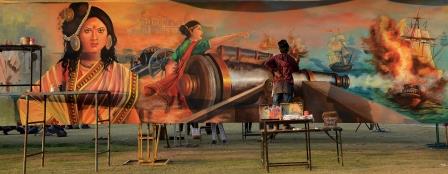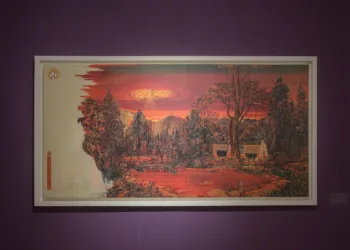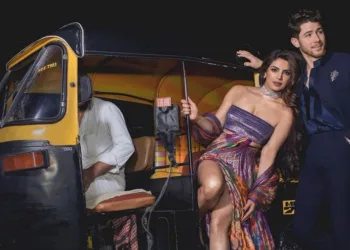BY SUJATA PRASAD: A former civil servant, Sujata Prasad is an acclaimed author and columnist.
The curtains closed on 2021 with a veritable explosion of creativity. The National Gallery of Modern Art, a premier institution of the Ministry of
Culture, organised regional workshops involving hundreds of indigenous and contemporary artists, as part of the ongoing Azadi Ka Amrit Mahotsav. The novel idea of using the powerful vocabulary of visual art forms to showcase the legacy of the freedom struggle and India’s rich cultural heritage resulted in a unique collaboration between the ministries of culture and defence. Display of painted scrolls, stretching over a kilometre at Rajpath in New Delhi during the Republic Day celebrations, are a form of tribute to the valour of freedom fighters, many of whom
remain unsung.
Five scrolls, each 75 metres long, were created in workshops held in Bhubaneswar and Chandigarh, on the vast campuses of the Kalinga Institute of Social Sciences, the Silicon Institute of Technology, and Punjab’s Chitkara University. Artists in hundreds gathered from different parts of the country, forming an impressive microcosm of the country’s creative DNA. With encouragement and advice from a team of senior mentors, they worked on individual themes and used a ladder to paint the upper reaches of the 10-foot-wide canvas.
A broad consensus was reached on the compositional structure of each of the scrolls, the subtleties of use of specific colours, and the contours of major images. The mentors managed to recreate the ambience of Kala Bhavan, the school of visual arts set up by Rabindranath Tagore in Santiniketan. The school was lovingly nurtured by Nandalal Bose, Ramkinkar Baij, and Benode Behari Mukherjee – the trinity of contextual modernism in Indian art. As they painted under the open skies, the camaraderie of the close-knit community of artists was a joy to behold.
“The workshops had a festive air…we were encouraged to share our dreams and aspirations and give visual form to our perception of history, particularly of the freedom movement. We sometimes painted through the night, enjoying every moment of the collective process,” reminisced a young Gond artist from Madhya Pradesh. “The alchemy between artists from the Bhil, Pithora, Gond, Warli, Madhubani, Manjusha, Jadupatua, Pattachitra, Sohrai, and several other socalled folk traditions and the contemporary artists was wonderful. It was as if a few
drops of nectar from Garuda’s pitcher of immortality had fallen on us too, amplifying the beauty of our collective effort,” added a contemporary artist from Andhra Pradesh.
The positive energy exuded by the artists was a welcome change after months of isolation during the first and second phases of the pandemic. “As a community, we were hit by the blight of Covid. Many of the proposed exhibitions seemed to wither away, galleries and museums were shut – the smaller ones permanently – while displays moved to digital spaces or hybrid forms of digital and limited in-person experiences. For us, coming together like this was no less than a deeply spiritual experience, like taking a dip at the holy Sangam. The joy of working together for a national cause was truly infectious,” observed an artist from Odisha, watching the line-up of dance and music performances choreographed for the occasion by the Zonal Cultural Centres.
Nandalal Bose’s evocative illustrations for the Indian Constitution inspired a recurrent theme running through the panels on the upper border. On January 26, 1950, after 165 days of deliberation, 284 members of the Constituent Assembly unanimously accepted the proposed constitutional text. The original calligraphed copies were sent to the iconic artist in Santiniketan to be illustrated so as to represent India’s rich
cultural heritage. Using the traditional technique of application of gold leaf and stone colour, Bose and his group of young artists created 22 historic images which left an indelible imprint on the collective consciousness of independent India. The images and this same sense are reincarnated in the colourful and evocative scrolls: the Zebu bull motif seal from Mohenjodaro and Harappa, the revered tradition of gurukul
from the Vedic era, images from the Ramayana and Mahabharata, the scene of Arjun’s penance at Mahabalipuram, the Chola Nataraja, Gautam Buddha’s enlightenment, and a host of others.
The man behind the conceptualisation of this idea is Adwaita Gadanayak, the self effacing director general of the National Gallery of Modern Art, who is also the vicepresident of the Indian Council for Cultural Relations. “It is important for museums to move beyond their walls and reach out to people. What we have created is a vibrant visual narrative, one of the most spellbinding commemorations of India’s independence. We have bridged the chasm between urban and rural, folk and contemporary, building a bridge across regions, communities, and cultures. Hundreds of artists have come together in the Kala Kumbhs, each participating artist and art form is represented, yet there is a unifying oneness in the visual vocabulary used for the occasion. I imagine that the same feeling of oneness must have inspired the multitudes of artists who would have come together to paint the Ajanta murals more than 2,000 years ago. Can there be a better way to celebrate our wonderful
heritage and civilisation?”
@sujataprasad








